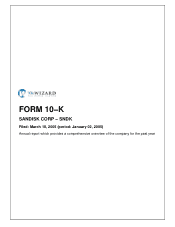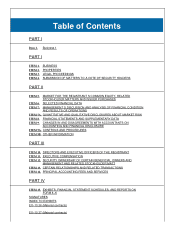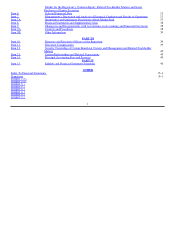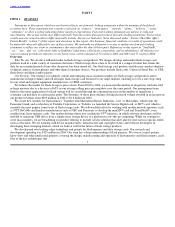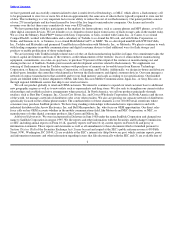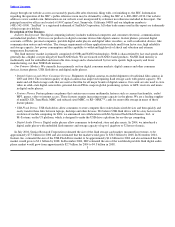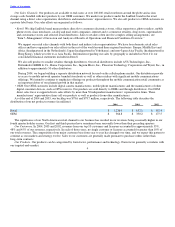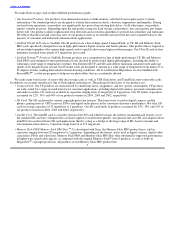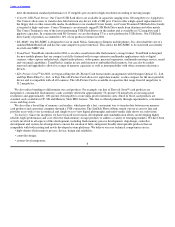SanDisk 2004 Annual Report Download - page 6
Download and view the complete annual report
Please find page 6 of the 2004 SanDisk annual report below. You can navigate through the pages in the report by either clicking on the pages listed below, or by using the keyword search tool below to find specific information within the annual report.
Table of Contents
PART I
ITEM 1. BUSINESS
Statements in this report, which are not historical facts, are forward−looking statements within the meaning of the federal
securities laws. These statements may contain words such as “expects,” “anticipates,” “intends,” “plans,” “believes,” “seeks,”
“estimates” or other wording indicating future results or expectations. Forward−looking statements are subject to risks and
uncertainties. Our actual results may differ materially from the results discussed in these forward−looking statements. Factors that
could cause our actual results to differ materially include, but are not limited to, those discussed under “Factors That May Affect
Future Results” in Item 7 of this report and elsewhere in this report. Our business, financial condition or results of operations could
be materially adversely affected by any of these factors. We undertake no obligation to revise or update any forward−looking
statements to reflect any event or circumstance that arises after the date of this report. References in this report to “SanDisk®,”
“we,” “our,” and “us” collectively refer to SanDisk Corporation, a Delaware corporation, and its subsidiaries. All references to
years or annual periods are reference to our fiscal years, which consisted of 52 weeks in 2002 and 2003 and 53 weeks in 2004.
Overview
Who We Are. We are the worldwide leader in flash storage card products. We design, develop and market flash storage card
products used in a wide variety of consumer electronics. Flash storage allows data to be stored in a compact format that retains the
data for an extended period of time after the power has been turned off. Our flash storage card products enable mass−market adoption
of digital cameras, feature phones and other digital consumer devices. Our products include flash cards, Universal Serial Bus, or USB,
flash drives and digital audio players.
Our Strategy. Our strategy is to identify current and emerging mass consumer markets for flash storage card products and to
manufacture in high volumes and sell all major flash storage card formats for our target markets, enabling us to be a one−stop−shop
for our retail and original equipment manufacturer, or OEM, customers.
We believe the market for flash storage is price elastic. From 2002 to 2004, we increased the number of megabytes sold nine fold,
in large measure due to a decrease of 63% in our average selling price per megabyte over the same period. Our management team
believes that more applications for flash storage will be created through the continued increase in the number of megabytes a
consumer can purchase at a given price point. The dynamics of these price declines driving increased volume resulted in an increase in
our product revenues from $493 million in 2002 to $1.6 billion in 2004.
We create new markets for flash memory. Together with Matsushita Electric Industries., Ltd., or Matsushita, which owns the
Panasonic brand, and a subsidiary of Toshiba Corporation, or Toshiba, we launched the Secure Digital card, or SDtm card, which is
currently the most popular form factor of flash storage cards. We followed that effort by working with mobile network operators such
as NTT DoCoMo and handset manufacturers such as NEC and Panasonic to develop the miniSDtm card and TransFlashtm, even
smaller form factor memory cards. Our market driving efforts now include the U3tm initiative, in which software developers will be
enabled to transform USB drives from a simple mass storage device to a platform for on−the−go computing. While we continue to
serve mass markets, we are broadening our product offering to include system solutions that add value for end−users in specific fields
such as education. We are working with device manufacturers, infrastructure and copyright owners and software developers in
developing these emerging markets, which we believe will be the future of flash storage products.
We develop and own leading−edge technology and patents for flash memory and data storage cards. Our research and
development spending was $125 million in 2004. Our team has a deep understanding of flash memory. We own or control patents,
know−how and other intellectual property covering the design, manufacturing and operation of flash memory and flash memory cards.
One of the key technologies that 1

